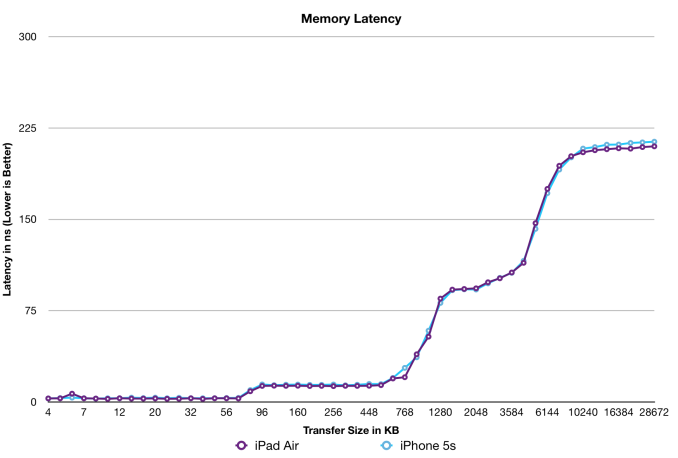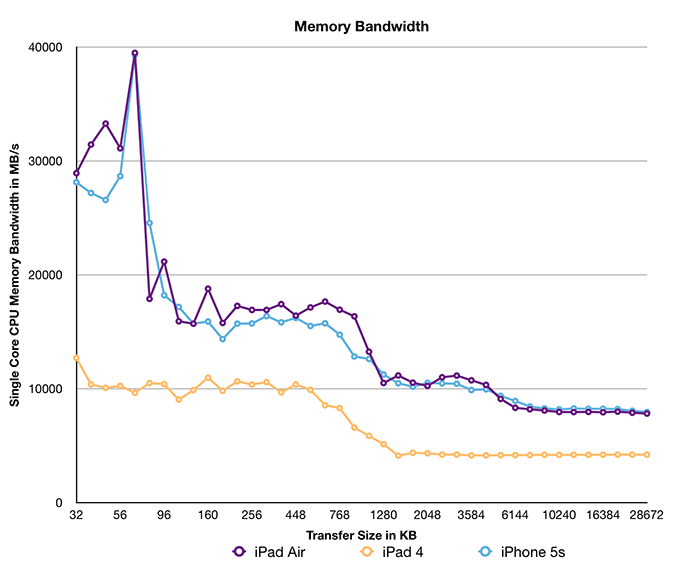The iPad Air Review
by Anand Lal Shimpi on October 29, 2013 9:00 PM ESTAn Update on Apple’s A7: It's Better Than I Thought
When I reviewed the iPhone 5s I didn’t have much time to go in and do the sort of in-depth investigation into Cyclone (Apple’s 64-bit custom ARMv8 core) as I did with Swift (Apple’s custom ARMv7 core from A6) the year before. I had heard rumors that Cyclone was substantially wider than its predecessor but I didn’t really have any proof other than hearsay so I left it out of the article. Instead I surmised in the 5s review that the A7 was likely an evolved Swift core rather than a brand new design, after all - what sense would it make to design a new CPU core and then do it all over again for the next one? It turns out I was quite wrong.
Armed with a bit of custom code and a bunch of low level tests I think I have a far better idea of what Apple’s A7 and Cyclone cores look like now than I did a month ago. I’m still toying with the idea of doing a much deeper investigation into A7, but I wanted to share some of my findings here.
The first task is to understand the width of the machine. With Swift I got lucky in that Apple had left a bunch of public LLVM documentation uncensored, referring to Swift’s 3-wide design. It turns out that although the design might be capable of decoding, issuing and retiring up to three instructions per clock, in most cases it behaved like a 2-wide machine. Mix FP and integer code and you’re looking at a machine that’s more like 1.5 instructions wide. Obviously Swift did very well in the market and its competitors at the time, including Qualcomm’s Krait 300, were similarly capable.
With Cyclone Apple is in a completely different league. As far as I can tell, peak issue width of Cyclone is 6 instructions. That’s at least 2x the width of Swift and Krait, and at best more than 3x the width depending on instruction mix. Limitations on co-issuing FP and integer math have also been lifted as you can run up to four integer adds and two FP adds in parallel. You can also perform up to two loads or stores per clock.
I don’t yet have a good understanding of the number of execution ports and how they’re mapped, but Cyclone appears to be the widest ARM architecture we’ve ever seen at this point. I’m talking wider than Qualcomm’s Krait 400 and even ARM’s Cortex A15.
I did have some low level analysis in the 5s review, where I pointed out the significantly reduced memory latency and increased bandwidth to the A7. It turns out that I was missing a big part of the story back then as well…
A Large System Wide Cache
In our iPhone 5s review I pointed out that the A7 now featured more computational GPU power than the 4th generation iPad. For a device running at 1/8 the resolution of the iPad, the A7’s GPU either meant that Apple had an application that needed tons of GPU performance or it planned on using the A7 in other, higher resolution devices. I speculated it would be the latter, and it turns out that’s indeed the case. For the first time since the iPad 2, Apple once again shares common silicon between the iPhone 5s, iPad Air and iPad mini with Retina Display.
As Brian found out in his investigation after the iPad event last week all three devices use the exact same silicon with the exact same internal model number: S5L8960X. There are no extra cores, no change in GPU configuration and the biggest one: no increase in memory bandwidth.
Previously both the A5X and A6X featured a 128-bit wide memory interface, with half of it seemingly reserved for GPU use exclusively. The non-X parts by comparison only had a 64-bit wide memory interface. The assumption was that a move to such a high resolution display demanded a substantial increase in memory bandwidth. With the A7, Apple takes a step back in memory interface width - so is it enough to hamper the performance of the iPad Air with its 2048 x 1536 display?
The numbers alone tell us the answer is no. In all available graphics benchmarks the iPad Air delivers better performance at its native resolution than the outgoing 4th generation iPad (as you'll soon see). Now many of these benchmarks are bound more by GPU compute rather than memory bandwidth, a side effect of the relative lack of memory bandwidth on modern day mobile platforms. Across the board though I couldn’t find a situation where anything was smoother on the iPad 4 than the iPad Air.
There’s another part of this story. Something I missed in my original A7 analysis. When Chipworks posted a shot of the A7 die many of you correctly identified what appeared to be a 4MB SRAM on the die itself. It's highlighted on the right in the floorplan diagram below:

A7 Floorplan, Courtesy Chipworks
While I originally assumed that this SRAM might be reserved for use by the ISP, it turns out that it can do a lot more than that. If we look at memory latency (from the perspective of a single CPU core) vs. transfer size on A7 we notice a very interesting phenomenon between 1MB and 4MB:
That SRAM is indeed some sort of a cache before you get to main memory. It’s not the fastest thing in the world, but it’s appreciably quicker than going all the way out to main memory. Available bandwidth is also pretty good:
We’re only looking at bandwidth seen by a single CPU core, but even then we’re talking about 10GB/s. Lookups in this third level cache don’t happen in parallel with main memory requests, so the impact on worst case memory latency is additive unfortunately (a tradeoff of speed vs. power).
I don’t yet have the tools needed to measure the impact of this on-die memory on GPU accesses, but in the worst case scenario it’ll help free up more of the memory interface for use by the GPU. It’s more likely that some graphics requests are cached here as well, with intelligent allocation of bandwidth depending on what type of application you’re running.
That’s the other aspect of what makes A7 so very interesting. This is the first Apple SoC that’s able to deliver good amounts of memory bandwidth to all consumers. A single CPU core can use up 8GB/s of bandwidth. I’m still vetting other SoCs, but so far I haven’t come across anyone in the ARM camp that can compete with what Apple has built here. Only Intel is competitive.












444 Comments
View All Comments
ancientarcher - Wednesday, October 30, 2013 - link
Great review Anand!Looking at the comments it seems that you just can't satisfy everyone. Well done though. Good job!
Having said that, let me now put forward my complaints. Why do you only have javascript benchmarks for the CPU?? I understand there is no ideal CPU benchmark, but what harm will it do to include a few. Nothing is perfect, but if you watch out for the usual tricks that the OEMs/chip suppliers play, you should be able to capture most if not all. Would love to see Geekbench at least in the benchmark set, for both the processor and single core results.
errorr - Wednesday, October 30, 2013 - link
Um, what cross platform benchmark exists? I don't really see any valid possibilities out there right now and nobody is more vocal about it than Anand seems to be.Spunjji - Wednesday, October 30, 2013 - link
"An interesting side effect of Apple’s pricing structure is that the cost for NAND upgrades actually gets pretty reasonable at the higher capacities."That actually made me laugh. I guess that's one way to look at it. From my perspective it's still a rip-off no matter which way you shake it...
VengenceIsMineX - Wednesday, October 30, 2013 - link
Seriously. While it is interesting, this is the one point where I think Anand's affection for Apple products has seriously affected his judgement. He would be just hammering ANY other manufacturer for charging $100 for 16 gb of NAND at today's prices but he not only gives them a pass on that, he bends over backward to point out that 64 GB to 128 GB is "only" another $100. Come on Anand, you are better than that.Spunjji - Tuesday, November 5, 2013 - link
Precisely! Thank you. I can understand the "it's their pricing structure" argument for why they charge that much (people still buy it, so why not) but there's no need to try to make it sound generous when it quite clearly is not.VengenceIsMineX - Wednesday, October 30, 2013 - link
Interesting iteration of hardware, particularly the SOC and a very solid technical review but I think in all fairness Anand, you didn't address the elephant in the room which is Apple's adherence to the $499 full size ipad price point, shameless storage & LTE gouging & what sort of value this offers. With the evolution of great smaller 7" tablets on the Android side and Windows 8.1 Bay Trail devices like the ASUS T100 coming in at prices of less than $230 and $349 respectively, you have to address what sort of value this thing offers for people who will consider it from a value perspective. Sure the Apple faithful will buy it but should those who aren't invested in Apple's ecosystem consider what is a very, very steep price in today's market? You address this in other reviews, why not here?(you do mention the storage pricing but honestly, I think at this point given NAND prices, you would be calling ANY other manufacturer to account for charging $100 for an additional 16 GB of storage, instead you bend over backward to point out how affordable the jump from 64 to 128 is. Really??? That's your take on this????)
darkcrayon - Wednesday, October 30, 2013 - link
I think your assertion about "Apple faithful" is a bit outdated. At the numbers the iPad sells, it's hard to say only a small subset of "special" people who only like Apple are buying them. Obviously a lot of people think the iPad is still worth $500, and you're not going to see a price drop until that changes. I do agree a comparison with inexpensive Windows based tablets is in order though.friendlystanger - Wednesday, October 30, 2013 - link
I am new user of this site and I am nost sure what 2 wide system means. Can anyone clarify this ?errorr - Wednesday, October 30, 2013 - link
It has to do with how many instructions van be processed by a single core on each cycle. It is a major bottleneck but comes with a huge power penalty to go wider usually.Just adding extra cores is only one way to increase parallelism.
friendlystanger - Wednesday, October 30, 2013 - link
Where can I learn more about these things? Any book,tutorial ? BTW thank you very much for your reply.